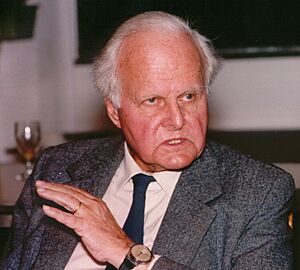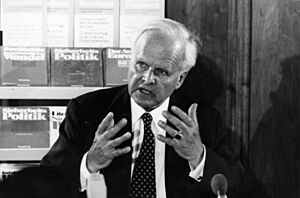Carl Friedrich von Weizsäcker facts for kids
Quick facts for kids
Carl Friedrich von Weizsäcker
|
|
|---|---|

Weizsäcker in 1993
|
|
| Born |
Carl Friedrich Freiherr von Weizsäcker
28 June 1912 Kiel, Schleswig-Holstein, German Empire
|
| Died | 28 April 2007 (aged 94) Starnberg, Bavaria, Germany
|
| Alma mater |
|
| Known for |
|
| Awards |
|
| Scientific career | |
| Fields | Physics, philosophy |
| Institutions | Max Planck Institute |
| Doctoral advisor | Friedrich Hund |
| Doctoral students | Karl-Heinz Höcker |
Carl Friedrich von Weizsäcker (born June 28, 1912 – died April 28, 2007) was an important German physicist and philosopher. He was part of a team that researched nuclear science in Nazi Germany during World War II. This team was led by Werner Heisenberg. There is still discussion about whether he and the other scientists actively tried to build a nuclear bomb for Germany.
Carl Friedrich was a member of the well-known Weizsäcker family. His father was a diplomat named Ernst von Weizsäcker. His younger brother, Richard von Weizsäcker, later became the President of Germany. Carl Friedrich's son, Ernst Ulrich von Weizsäcker, is a physicist and environmental researcher.
Weizsäcker made major discoveries about how stars produce energy through a process called nuclear fusion. He also did important work on how planets formed in our early Solar System. Later in his life, he focused more on ideas about philosophy, ethics (right and wrong), and history. He received many international awards for this work.
Contents
Early Life and Studies
Carl Friedrich von Weizsäcker was born in Kiel, Germany. His grandfather, Karl Hugo von Weizsäcker, was a Prime Minister. In 1916, his grandfather was given the title of Baron (Freiherr). This meant that four-year-old Carl Friedrich also became a Baron.
He grew up in different cities, including Stuttgart, Basel, and Copenhagen. From 1929 to 1933, he studied physics, mathematics, and astronomy. He studied at universities in Berlin, Göttingen, and Leipzig. During this time, he worked with famous scientists like Werner Heisenberg and Niels Bohr. His main teacher for his doctoral degree was Friedrich Hund.
How Stars Make Energy
As a young scientist, Weizsäcker was very interested in how stars create energy. He also studied the energy that holds atomic nuclei together. Working with Hans Bethe, he discovered a cycle that explains how stars produce energy through nuclear fusion. This discovery is known as the Bethe–Weizsäcker process (published between 1937 and 1939).
This is different from an earlier formula he developed in 1935. That formula, called the Bethe–Weizsäcker formula, helped scientists understand the energy and mass of atomic nuclei.
How Planets Formed
In 1938, Weizsäcker created a theory about how our Solar System was formed. His idea was based on how lighter and heavier elements are spread out in the Sun and the terrestrial planets. His ideas were later accepted and improved by many other scientists.
According to his theory, the Sun and its planets came from a giant cloud of gas. This cloud was mostly made of hydrogen and helium (99%), with only a small amount (1%) of heavier elements. About 10% of this cloud stayed around the Sun as a large atmosphere. The 1% of heavier elements in this atmosphere eventually formed the planets we see today. This amount matches the fact that planets make up about 1% of the Solar System's mass.
His theory also helped explain why the planets' orbits get bigger the farther they are from the Sun. This happens because "planetary eddies" of gas and dust were larger farther away from the center of the early solar system.
Another important idea from his theory was that many other stars in the universe, similar to our Sun, likely have their own planetary systems.
Work During World War II
When nuclear fission was discovered in 1939 by Otto Hahn and Lise Meitner, Weizsäcker and many other physicists quickly realized that nuclear weapons could be built. He talked about these serious implications with his friend, philosopher Georg Picht, in February 1939.
During World War II, Weizsäcker joined the German nuclear weapons program. He worked on trying to build an atomic bomb at the Kaiser Wilhelm Institute in Berlin. In August 1939, Albert Einstein even sent a letter to U.S. President Franklin D. Roosevelt warning him about this research. Einstein mentioned that "the son of the German Under-Secretary of State, von Weizsäcker, is attached to the Kaiser-Wilhelm-Institut in Berlin where some of the American work on uranium is now being repeated."
As a student of Werner Heisenberg, Weizsäcker was at a key meeting in Berlin in September 1939. This meeting officially started the German atomic weapons program. Early in the war, he hoped that a successful nuclear weapons project would give him political influence. In July 1940, he helped write a report for the army. This report discussed how to produce energy from refined uranium. It also mentioned the possibility of using plutonium to create new types of explosives. In the summer of 1942, Weizsäcker even applied for a patent for a portable "process to generate energy and neutrons by an explosion... e.g. a bomb." This patent application was found in Moscow in the 1990s.
Historians still discuss whether Heisenberg and his team truly wanted to build a nuclear weapon. Some believe they didn't want the Nazi government to have such a weapon. After the war, Weizsäcker said that they wanted to understand if chain reactions were possible, no matter what they would do with the knowledge. He also said that only by "divine grace" were they saved from the temptation to build the bomb, because Germany's war economy couldn't provide the needed resources.
After the atomic bomb was dropped in 1945, Weizsäcker and other German physicists were held in England. Their conversations were secretly recorded. Weizsäcker said that he believed they didn't build the bomb because the physicists didn't want to, on principle. However, these recordings also showed that Weizsäcker suggested they all claim they never wanted to develop a German nuclear weapon.
Weizsäcker himself stated that he, Heisenberg, and Karl Wirtz had a private agreement. They would study nuclear fission as much as possible to decide how to use it. He said there was no plot to avoid making the bomb, but also no strong desire to make it.
Later in the war, Weizsäcker worked as a professor in Strasbourg. When American forces captured his lab and papers there in December 1944, they learned that Germany was not close to developing a nuclear weapon.
After the War
In 1946, Weizsäcker was allowed to return to West Germany. He became the director of theoretical physics at the Max Planck Institute for Physics in Göttingen. From 1957 to 1969, he was a professor of philosophy at the University of Hamburg. In 1957, he received the Max Planck Medal.
From 1970 to 1980, he led the Max Planck Institute for the Research of Living Conditions in the Modern World. He studied and wrote about the dangers of nuclear war. He also focused on the differences between wealthy and developing countries. He researched the problems caused by environmental degradation.
He was one of eight scientists who signed the Memorandum of Tübingen. This document called for Germany to accept its border with Poland. It also spoke against West Germany getting nuclear weapons.
In the 1970s, he helped start a research foundation. It aimed to combine "western sciences and eastern wisdom." After he retired in 1980, he became a Christian pacifist. He spent more time working on the ideas behind quantum physics.
His experiences during the Nazi era made him very interested in questions of ethics and responsibility. In 1957, he was part of the Göttinger 18. This group of German physicists protested against West Germany's armed forces having tactical nuclear weapons. He also suggested that West Germany should promise never to have any kind of nuclear weapons.
Carl Friedrich von Weizsäcker passed away in 2007 at the age of 94. People still have different opinions on whether he fully accepted his responsibility for the German scientific efforts to build a nuclear weapon during World War II.
Theory of Ur-alternatives
Weizsäcker developed a theory called "ur-alternatives." He wrote about it in his book The Unity of Nature. This theory builds quantum physics from simple, observable choices. Weizsäcker used his theory to explain why space has three dimensions. He also used it to estimate the entropy of a proton falling into a black hole.
Awards and Honors
- 1957 Max Planck Medal
- 1958 Goethe Prize
- 1961 Pour le Mérite for Science and Art
- 1963 Peace Prize of the German Book Trade
- 1969 Erasmus Prize
- 1969 Austrian Medal for Science and Art
- 1973 Grand Merit Cross with Star and Sash of the Federal Republic of Germany
- 1982 Ernst Hellmut Vits Prize
- 1983 Heinrich Heine Prize
- 1988 Sigmund Freud Prize for Scientific Prose
- 1989 Templeton Prize for "Progress in Religion"
- 1989 Theodor Heuss Prize
- Honorary Degrees
- Law: Free University of Amsterdam, University of Alberta, University of Aberdeen
- Theology: University of Tübingen, University of Basel
- Science: Karl Marx University, Leipzig
- Philosophy: Berlin Institute of Technology, University of Aachen
- Memberships
- Max Planck Society
- German Academy of Sciences Leopoldina
- Göttingen Academy of Sciences
- Saxon Academy of Sciences
- Austrian Academy of Sciences
- Bavarian Academy of Sciences
- Bavarian Academy of Fine Arts
- German Physical Society
- Académie des Sciences Morales et Politiques
- American Physical Society
- Croatian Academy of Sciences and Arts
- German Academy for Language and Literature
- Joachim Jungius Society of Science
- Hamburg Institute for Human Sciences
A school in Barmstedt, Germany, the Carl Friedrich von Weizsäcker Gymnasium, is named after him.
Weizsäcker was nominated four times for the Nobel Prize in Physics. Since 2009, an award called the "Carl Friedrich von Weizsäcker Award" is given every two years. It honors great scientific work that helps solve important social problems. There is also a Carl-Friedrich von Weizsäcker Foundation.
Works
- The World View of Physics (1946)
- The History of Nature (1948)
- The Unity of Nature (1971)
- The Politics of Peril (1976)
- The Ambivalence of Progress (1977)
- The Biological Basis of Religion and Genius (1971, with Gopi Krishna)
- The Structure of Physics (1985)
- Man in His History (1991)
- Time and Knowledge (1992)
- The Threatened Peace (1994)
- Great Physicists (1999)
See also
 In Spanish: Carl Friedrich von Weizsäcker para niños
In Spanish: Carl Friedrich von Weizsäcker para niños
- Bethe–Weizsäcker cycle or CNO cycle
- Liquid drop model
- The Heavy Water War


